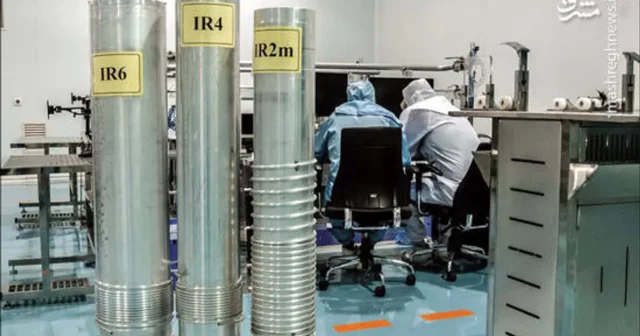Iran has responded to last week’s UN nuclear watchdog censure resolution by expanding its uranium enrichment capacity at two underground sites.
Iran has rapidly installed two more cascades, or clusters, of uranium-enriching centrifuges at its Fordow site and begun work on more while also planning others at its underground plant at Natanz, a UN nuclear watchdog report seen by Reuters said.
“On 9 and 10 June … Iran informed the Agency that eight cascades each containing 174 IR-6 centrifuges would be installed over the next 3-4 weeks in Unit 1 of FFEP (Fordow Fuel Enrichment Plant),” the confidential International Atomic Energy Agency report sent to member states on Thursday said.
“On 11 June 2024, the Agency verified at FFEP that Iran had completed the installation of IR-6 centrifuges in two cascades in Unit 1. Installation of IR-6 centrifuges in four additional cascades was ongoing,” the report said, referring to one of one of Iran’s most advanced centrifuge models.
While non-binding, resolutions by the International Atomic Energy Agency’s 35-nation Board of Governors anger Tehran, which typically responds by accelerating its nuclear activities.
Eighteen months earlier, Iran responded to a similar resolution by enriching uranium to up to 60% purity—close to weapons-grade—at a second site and announcing a significant expansion of its enrichment program.
Reuters cited unnamed diplomats as saying Wednesday that this time Tehran plans to install more cascades, or clusters, of centrifuges, the machines that enrich uranium, at both its underground enrichment sites.
“It’s not as much as I would expect,” one Vienna-based diplomat said, referring to the scale of Iran’s escalation. “Why? I don’t know. Maybe they’re waiting for the new government,” they said, referring to the death in a helicopter crash last month of Iranian President Ebrahim Raisi and Foreign Minister Hossein Amir-Abdollahian. The presidential election is due to be held on June 28.
The IAEA Board passed a resolution a week ago calling on Iran to step up cooperation with the agency and reverse its recent decision to bar visits by inspectors.
The resolution was tabled by the Britain, France and Germany, which the United States reportedly opposed but later endorsed. Only Russia and China voted against the measure.
Ali Shamkhani, a senior aide to Iran’s Supreme Leader, who has been reportedly put in charge of Iran’s nuclear negotiations, had warned that Iran would deliver a “serious and effective response” if European nations pursue the resolution.
Iran’s nuclear chief Mohammad Eslami claimed earlier this month that Tehran is adhering to the Nuclear Non-Proliferation Treaty (NPT) agreements, but is “in the process of reducing its nuclear obligations” under the 2015 nuclear deal, known as the Joint Comprehensive Plan of Action (JCPOA). The E3 maintains that Iran has signed and ratified the NPT Safeguards Agreement but has not adhered to its legally binding obligations.
In 2018, then-US President Donald Trump withdrew from the JCPOA, arguing that the agreement did not sufficiently prevent Tehran from acquiring a nuclear weapon. Consequently, the US re-imposed unilateral sanctions on Iran’s economy.
Reuters sources did not go into specifics on the number or type of centrifuges being added or what level they would enrich to, though one diplomat said they would not be used to quickly expand Iran’s production of uranium enriched to up to 60%, close to the 90% required for production of atomic bombs.
The diplomats said they would wait to see what the IAEA said Iran had actually done but they were aware of Iran’s plans. The move is “at the lower end of expectations and something we’re pretty sure they were going to do anyway”, one diplomat said, meaning it would have happened even without the resolution.
Iran did not fully follow through on its November 2022 announcement of a tough retaliation after the previous resolution. While it installed all the centrifuges it said it would at its underground enrichment plant at Natanz, 12 cascades of one advanced model, the IR-2m, are not yet in operation.
Iran is only enriching to up to 60% at an above-ground pilot plant at Natanz and its Fordow site, which is dug into a mountain. In November 2022 it started enriching to up to 60% at Fordow but it has yet to install all the additional cascades it said it would.
IAEA Chief Rafael Grossi acknowledged last week that the agency has lost continuity of knowledge regarding the production of centrifuges, rotors and bellows, heavy water, and uranium as Iran continues to expand its nuclear program.
In response to a question by Iran International’s Ahmad Samadi about the censure resolution by the European countries, Grossi stated that the member countries must express their opinions on the matter and that the Agency is only required to comply with the resolution if it is approved.






















